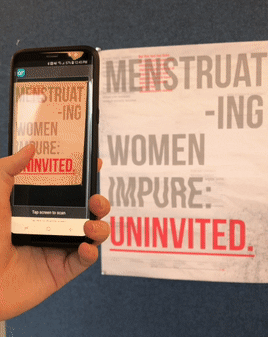
THE CHALLENGE
In rural India, women are barred from entering the kitchen and/or temples when on their period.
Initially a hygiene challenge, this tradition has been reconstructed over time into notions of impiety, disgust and social isolation.
THE SOLUTION
Retracing how this tradition morphed over time and the factors that influenced it, through an interactive poster using augmented reality to represent the message.
.

"Amba Bohara and her two children have died of suspected smoke inhalation after a night in a menstrual hut in Nepal, according to police.
The windowless hut, where women are banished during their period, was filled with smoke after the woman lit a fire to keep herself and her children warm."
- The Telegraph, 10 January 2019
Image by Paulomi Basu
What is Menstrual Exclusion?
Across many developing areas of India and Nepal, Menstrual exclusion huts (Chhaupadi) are mandated. Menstruating women are banished to an outdoor hut, sometimes with their children and are unable to visit temples, use other villagers’ kitchen utensils or wash in communal water sources. In the Hindu religion, it is considered bad luck to touch menstruating women and girls.
WHAT IS THE IMPACT?
Many women die in the huts — typically from exposure, animal bites or smoke inhalation after building fires to stay warm during the Himalayan winters. Reports of sexual assault from men who prey on women while they stay alone are also common.
Needless to say, it also disrupts education among girls and significantly reduces their confidence to compete in a predominantly patriarchal society.
HOW DID THIS BEGIN?
Without present day hygiene products, menstruation was physically an unclean experience. Women used rag cloths (that never saw sunlight due to stigma) and even wood ash to soak menstrual blood. Soon, unclean and impure were used synonymously in purification rituals (ablutions) prescribed by the Hindu religion, to a person about to worship. Thus, body fluids were deemed impure prohibiting menstruating women from such public spaces.
WHY KITCHEN & TEMPLES?
At the time of the origin of this tradition, women frequented these two places the most, being the home-maker. While kitchens needed to be free of contamination, temples had high footfall making physical contact inevitable.
Restrictions from entering the temple while unclean, were no different than the present day ablutions like cleaning your feet to enter a Gurudwara (Sikh Temple) or washing your hands and face before entering a mosque.


Chhaupadi- Menstrual exclusion huts


Religious ablutions

Where are we now?
In 2019, a large number of this rural population has migrated to cities with easy access to hygiene products. Even within the rural context, feminine hygiene has drastically improved through low-cost innovations.
Yet, the notions of impurity are carried along and passed on from one generation to the next.
Image from Getty Images
Concept
The background and texture represents how women repeatedly used rag cloths to contains the flow. These cloths were so heavily contaminated that they were a breeding ground for bacteria. They were also too ashamed to dry it outside their house, leading to no possibility of sun-contact.
They also reportedly used ashes and soil to soak the flow, leading in generations of ovulation disorders.



What you can read from a distance is the notion that is prevalent in the society.
On moving closer there are several easter eggs in this poster that help de-mystify the origins and toxic reconstruction of this tradition.
Use Zappar App to read the correct message
Point app at the bottom left corner logo to activate interaction.
Poster design to represent misconstrued tradition
Image by Tara Todras


Nepal banned this practice in 2005. However, Rewati Raman Bhandari, a former lawmaker who drafted the measure that criminalized chhaupadi, said the push to eradicate the practice — from villagers, the police and local politicians — was still far too muted.
“Tradition is stronger than the law” he said.
-New York Times, 9 January 2019

DAAP Cares 2019 Conference - highlighting humanitarian design projects at University of Cincinnati

Graduate Student Expo Poster Forum 2019 - intra-university graduate research showcase
FURTHER AREAS OF WORK
I am currently presenting my ongoing findings to multiple stakeholders in the industry in an attempt to develop collaborations. This poster is one example of the social injustice faced by women on account of traditions and beliefs pulled out of context. It manifests in more forms than one and I seek to retrace the origins of such discrimination.
Beginning with a poster series, I am open to collaboration to eventually be able to direct this project to reach the target audience itself and lead behaviour change.
Use Zappar App to read the correct message
Point app at the bottom left corner logo to activate interaction.
